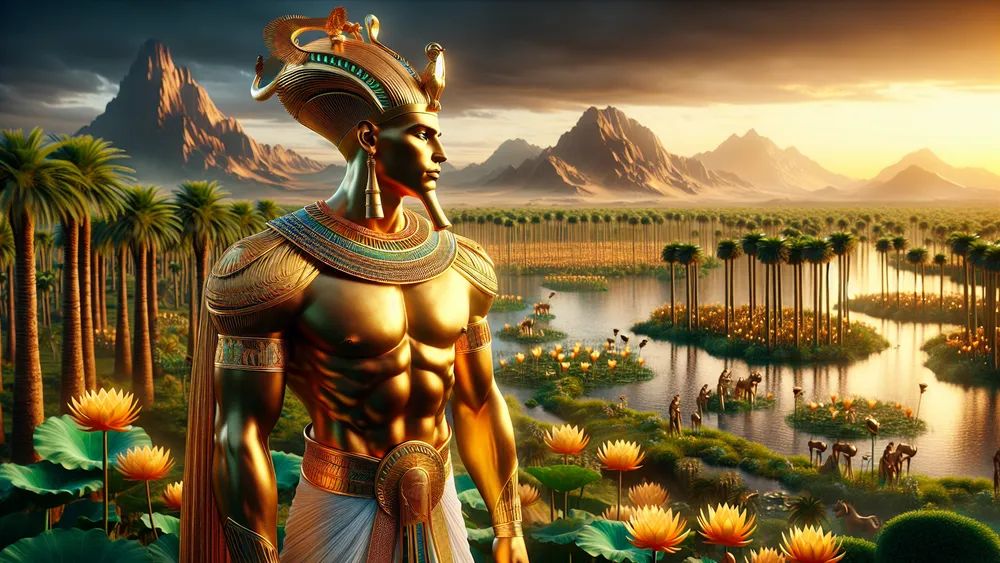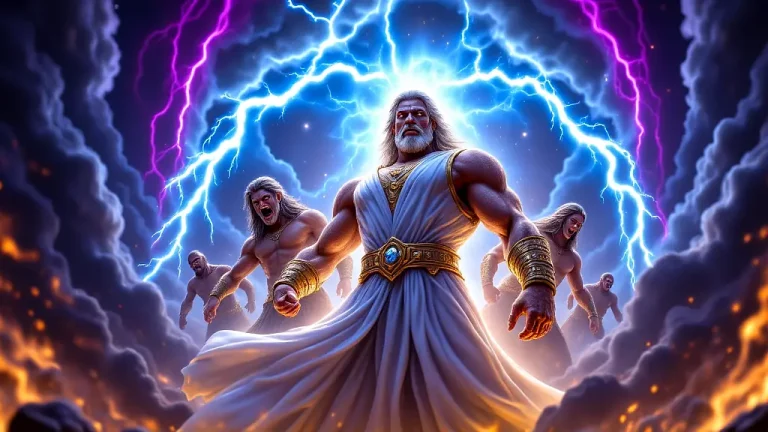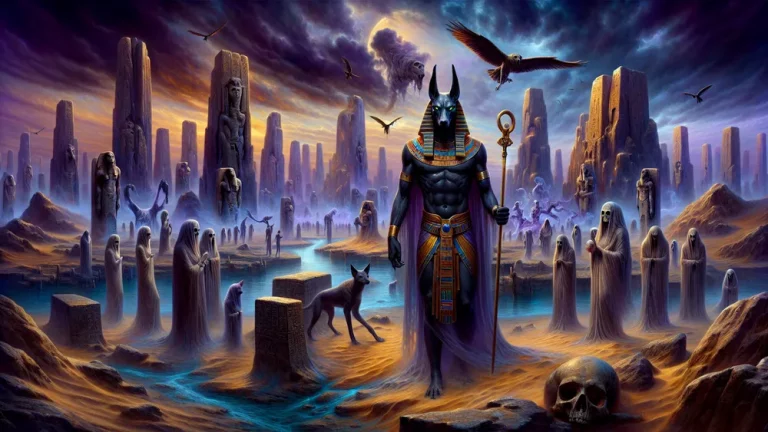Hapi: Ancient Egyptian God Of Nile And Fertility
Hapi, the ancient Egyptian god of the Nile and fertility, is a big deal in Egyptian mythology. People saw him as the divine force behind the Nile’s yearly floods, which made the soil rich and perfect for farming. This blog post dives into Hapi’s many roles in mythology, culture, and everyday life. We look at how he’s depicted, his symbols, and the rituals people did to honor him.
Key Points:
- Hapi is the ancient Egyptian god of the Nile and fertility.
- Hapi’s annual flooding of the Nile ensures soil fertility for agriculture.
- Depicted as a chubby figure with blue or green skin and headdress of aquatic plants.
- Hapi’s rituals and festivals play a vital role in Egyptian culture and religious life.
- Hapi is linked with other gods like Osiris and Isis in Egyptian mythology.
- The Nile’s flooding, controlled by Hapi, is crucial for agriculture and daily life in ancient Egypt.
By getting to know Hapi better, we see how deeply connected the natural world and religious beliefs were in ancient Egypt.
The Significance of Hapi in Ancient Egyptian Mythology
To get why Hapi matters, we need to look at who he is, what he does, and the symbolism tied to him in ancient Egyptian mythology. Let’s dive into his story and see what makes him special.
Who is Hapi?
Hapi is the ancient Egyptian god of the Nile. He’s the one they believe makes the river flood every year, which is super important for farming. In Egyptian mythology, Hapi’s job is to make sure the land stays fertile by bringing all that good silt and water to the fields. This helps crops grow and keeps everyone fed.
People often see Hapi as a symbol of abundance and nourishment. You know, he’s usually shown as a chubby figure with big breasts and a round belly, which means prosperity from the Nile’s floods. Sometimes, he even has blue or green skin to show he’s all about water and life.
- Hapi’s depictions often include aquatic plants like papyrus and lotus.
- He is sometimes shown carrying offerings of food and drink.
- Hapi was venerated in special festivals that coincided with the Nile’s inundation.
- Temples dedicated to Hapi were located near the Nile to honor his connection to the river.
Hapi, the Egyptian god of the Nile, ensures fertility and abundance by causing the river to flood yearly for prosperous farming and nourishment, which is celebrated through festivals and temples near the Nile.
The Role of Hapi in Egyptian Culture
Hapi’s got a big part in ancient Egyptian culture, especially when it comes to farming, fertility, and everyday life. The Nile’s yearly flooding, called the inundation, is super important because it makes the soil rich and great for growing crops. People believe this flood is Hapi’s doing. Farmers really count on Hapi’s blessings for good harvests, so they do all sorts of rituals and give offerings to keep him happy.
The Nile’s floods bring prosperity, so Hapi is seen as a god of plenty and nourishment. His influence is everywhere, from the food people eat to the overall health of the community. Worshipping Hapi involves lots of festivals and rituals that are a big deal in Egyptian religious life. One major festival is the “Feast of the Inundation,” which celebrates the Nile’s floodwaters arriving.
During this time, people offer food, drinks, and flowers to Hapi to keep his favor. Temples for Hapi are usually near the Nile and serve as places for worship and community events. Priests lead ceremonies with hymns, prayers, and processions to honor Hapi and ask for his blessings. These rituals aren’t just religious; they’re also community events that show how important Hapi is in keeping Egyptian society balanced and prosperous.
| Aspect | Details/Examples |
|---|---|
| Agriculture | Annual flooding of the Nile attributed to Hapi; essential for soil fertility and crop growth. |
| Fertility | Hapi’s blessings sought for successful harvests; symbolized abundance and nourishment. |
| Daily Life | Influence seen in food supply, community well-being; venerated as a god of sustenance. |
| Worship Practices | Offerings of food, drink, flowers; temples near the Nile; hymns, prayers, processions. |
| Festivals | “Feast of the Inundation” celebrated arrival of floodwaters; communal and religious significance. |
Hapi’s Depiction and Symbolism
So, when we talk about Hapi’s role in Egyptian culture, we also gotta look at how he shows up in art and what symbols are tied to him. Let’s dive into the artistic depictions and the deeper meanings behind his imagery.
Visual Representations of Hapi
Hapi usually shows up in ancient Egyptian art as a well-nourished, androgynous figure with a big belly. This symbolizes abundance and fertility. You often see him with blue or green skin, which stands for the life-giving waters of the Nile. He wears a headdress made of aquatic plants like papyrus and lotus. These plants are important symbols of Upper and Lower Egypt.
This look shows his role as a unifying god who brings prosperity to the whole land. Unlike many other Egyptian gods, Hapi has a fully human form, not an animal head. This makes him special and highlights his direct connection to nature and human sustenance.
You often see vases or jars overflowing with water in his depictions, which further points to his link with the Nile’s flooding and its key role in agriculture.
- Blue or green skin: Represents the Nile’s life-giving waters.
- Headdress of aquatic plants: Symbolizes unity between Upper and Lower Egypt.
- Fully human form: Differentiates Hapi from other gods with animal heads.
- Vases or jars overflowing with water: Emphasizes his role in the Nile’s inundation.
Hapi’s physical attributes and symbols emphasize his connection to the Nile’s fertility and prosperity for Egypt.
Symbols and Attributes of Hapi
Hapi has a bunch of symbols that mean a lot in ancient Egyptian culture. First off, he’s got blue or green skin. This shows the life-giving waters of the Nile, which are super important for farming and living. Then, there’s his headdress made of aquatic plants like papyrus and lotus. These plants stand for the unity between Upper and Lower Egypt.
Hapi’s figure is also quite special. He’s often shown with a big belly, looking well-nourished and kind of androgynous. This look symbolizes abundance and fertility, showing his role in making sure there’s a good harvest. You also see vases or jars overflowing with water in his images, which highlight his link to the Nile’s flooding.
These symbols aren’t just in art; they’re big in rituals too. During ceremonies for Hapi, people offer water and crops to get his blessings for a good season. His imagery is all over temple art and inscriptions, reminding everyone how important he is for keeping their land balanced and prosperous.
Hapi’s Influence on the Nile and Agriculture
So, when you get Hapi’s symbols and attributes, you see how he’s tied to the Nile and farming. Let’s dive into how Hapi’s blessings shape farming and make ancient Egypt thrive.
The Nile’s Importance in Ancient Egypt
The Nile River is like the heart of ancient Egypt. It gives water in a dry place. Every year, it floods and leaves behind nutrient-rich silt. This makes the soil super fertile, perfect for growing crops like wheat and barley. These crops are essential for food and trade. Hapi, the god of the Nile, is believed to control this flooding. People think he makes the land fertile.
They do rituals and give offerings to make sure Hapi is happy and blesses them with a good harvest.
- The Nile’s flooding cycle has three seasons: Akhet (Inundation), Peret (Growth), and Shemu (Harvest).
- Temples for Hapi are often near the Nile to show his connection to the river.
- Farmers use basins and canals to manage the floodwaters for irrigation.
- The Nile also serves as a major transportation route, helping with trade and communication.
Agricultural Practices and Hapi’s Blessings
Agricultural practices in ancient Egypt? They really revolve around Hapi, the god of the Nile. His annual flooding? Super important for making the soil rich with nutrients. Farmers? They count on this predictable inundation cycle to figure out when to plant and harvest. They use basin irrigation to spread water around.
To get a good harvest, they always look for Hapi’s blessings. How? Through rituals and offerings. They do ceremonial processions and prayers at Hapi’s temples, where priests offer food, drink, and other stuff to keep the god happy. During planting and harvest times, special festivals pop up to honor Hapi.
These involve elaborate ceremonies and communal gatherings that show how much they rely on him for their crops.
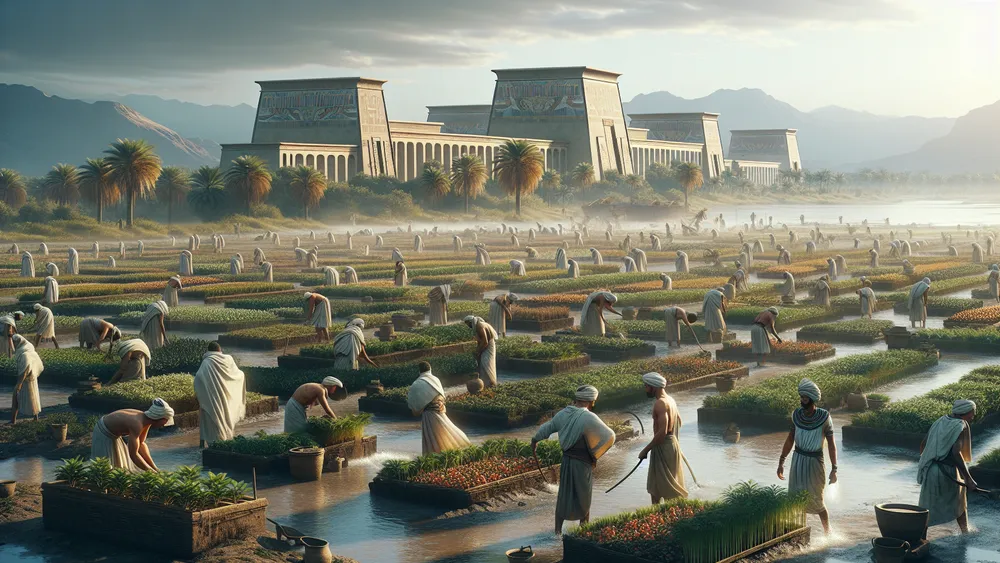
Agricultural practices in ancient Egypt heavily rely on Hapi, the god of the Nile, for the annual flooding which enriches the soil and guides planting and harvesting times through rituals and offerings.
Hapi in Egyptian Mythology and Stories
So, we’ve talked about Hapi’s role in agriculture and daily life. Now, let’s dive into the myths and legends that show why Hapi is such a big deal in the Egyptian pantheon.
Myths and Legends Involving Hapi
Hapi shows up in a bunch of myths and stories that really highlight how important he is in ancient Egyptian mythology. One story that people love talks about Hapi’s role in the yearly flooding of the Nile. They saw this flooding as a divine act that was super important for farming.
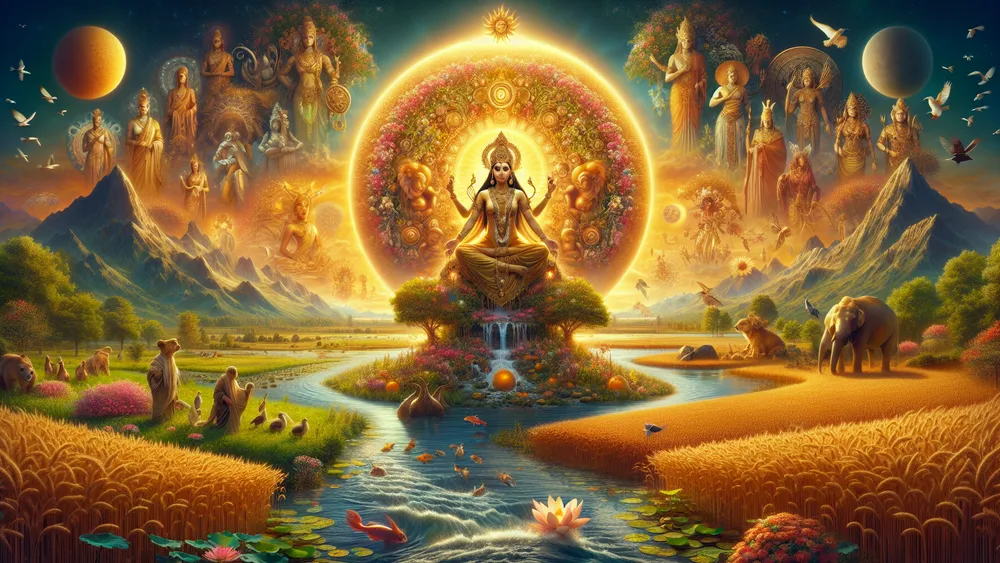
Folks believed that the flood happened because of Hapi’s tears of joy, which symbolized his kindness and his key role in keeping life going. Another story has Hapi in the creation myth, where he comes out of the waters of chaos, called Nun. This moment shows the start of order and fertility, making Hapi a big deal as a life-giver.
These legends often teach us to respect natural cycles and the divine forces behind them. Hapi also interacts with other gods a lot in these myths. For example, he’s often linked with Osiris, the god of the afterlife, and Isis, the goddess of magic and motherhood.
In some stories, Hapi provides the water needed for Osiris’s resurrection, showing his part in the cycle of life, death, and rebirth. Plus, Hapi sometimes works with other gods like Sobek, the crocodile god, to make sure the Nile stays fertile and full of life. These interactions really show how Hapi fits into the Egyptian pantheon and how he works with other gods to keep things balanced and prosperous.
- Hapi’s tears of joy: Believed to cause the annual flooding of the Nile.
- Primeval gods: Hapi emerged from Nun, symbolizing order and fertility.
- Association with Osiris and Isis: Highlights his role in life, death, and rebirth.
- Collaboration with Sobek: Ensures the Nile’s fertility and abundance.
Hapi’s Role in the Egyptian Pantheon
Hapi’s got a special spot among the Egyptian gods. He’s the deity of the Nile, which is super important for the people there. Unlike other gods who focus on specific things like war or love, Hapi’s influence is all about the annual flooding of the Nile. This flooding makes the land fertile, so it’s a big deal for farming.
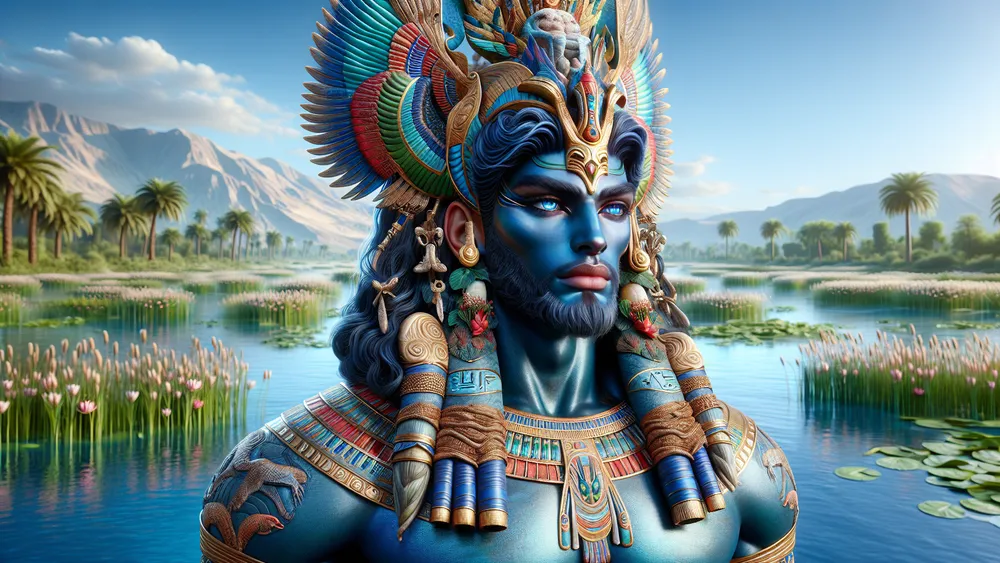
Because of this, he’s seen as a provider of life and food. He works closely with other gods too. For example, he’s often linked with Osiris, the god of the afterlife, and Isis, the goddess of magic and motherhood. This shows his role in the cycle of life and rebirth.
If you look at other cultures, Hapi is kinda like Tlaloc, the Aztec god of rain and fertility, or Indra, the Vedic god of rain and thunderstorms. These gods also make sure there’s enough water and fertile land for crops, which is super important for their people.
Pantheon of All the Egyptian Gods
The Egyptian pantheon? It’s huge. There are tons of gods and goddesses, each with their own special thing. They play a big part in the daily lives and beliefs of ancient Egyptians. If you want to dive deeper, check out this list of all the Egyptian gods.
FAQs
1. Who was Hapi in ancient Egyptian mythology?
Hapi, in ancient Egyptian mythology, is the god of the Nile and fertility. He’s the one who makes the river flood every year, which helps the soil and supports farming.
2. What was Hapi’s role in agriculture?
Hapi’s role in agriculture? Well, he makes sure the Nile floods every year. This flooding spreads fertile silt all over the land, which is great for farming. So, thanks to Hapi, the soil stays rich and crops can grow.
3. How was Hapi depicted in ancient Egyptian art?
You see, Hapi usually shows up in ancient Egyptian art as this well-fed guy. He’s got large breasts and a big belly, which is all about showing abundance and fertility.
4. What symbols are associated with Hapi?
You know, Hapi’s symbols are pretty interesting. They include the lotus, papyrus plants, and vases of water.

